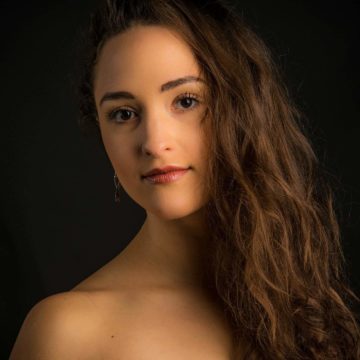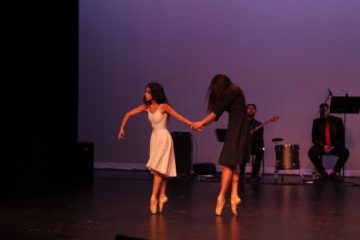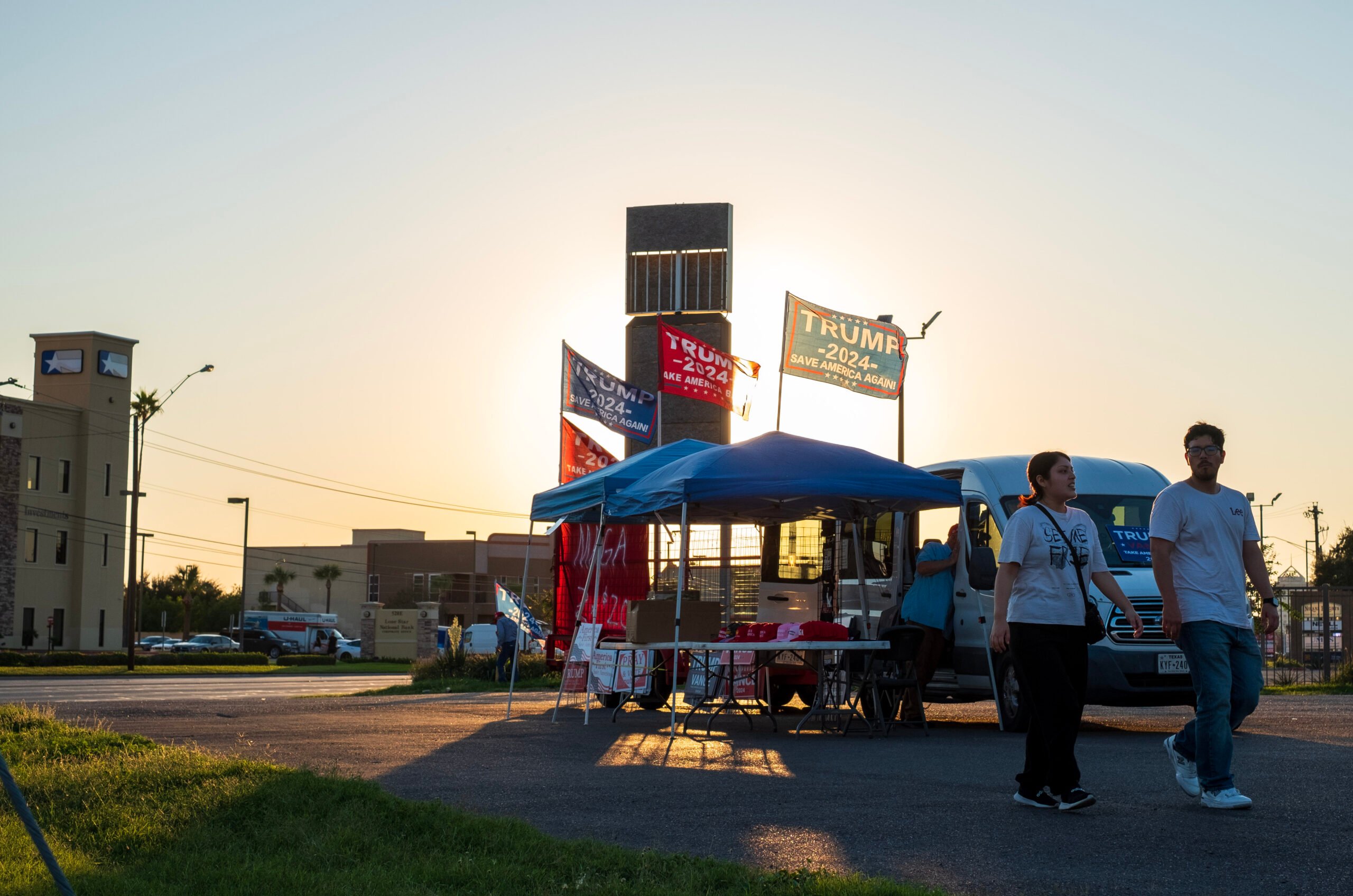Dance Without Borders
Ballet Nepantla erases boundaries between dance forms and explores what it means to be from the borderlands — both as a geographical place and a state of mind.
In the opening moments of “La Bruja,” a traditional folk dance from Veracruz newly reinterpreted by the New York City-based Ballet Nepantla, a spotlight trains on a barefoot dancer in a red dress — the witch — pirouetting at center stage. She is soon joined by a shirtless male “victim” who executes a series of acrobatic lifts as they take turns pursuing one another across the stage. It’s a prototypical contemporary ballet duet, until something surprising happens: Six dancers in flowing white dresses and high-heeled shoes emerge from the wings and place flickering candles atop their heads. Their feet strike an intricate pattern as the candles remain stationary, as though levitating. Meanwhile, the contemporary pair weaves in and out of the folk dancers in an ethereal braid entwining new and old, seduction and pursuit, and life and death.
The interplay between traditional and contemporary dance is at the heart of Ballet Nepantla, a fusion dance company formed early this year by Rio Grande Valley native Andrea Guajardo. The company’s name — taken from an Aztec word that translates to “in-between-spaces” — is a fitting description of its inaugural show, Sin Fronteras, which in November completed a three-city Texas tour with a performance in Guajardo’s hometown of Edinburg. By combining elements of contemporary and classical ballet with Mexican folklórico and Afro-indigenous traditions, the show erases boundaries between dance forms and explores what it means to be from the borderlands — both as a geographical place and a state of mind.

Guajardo is the daughter of a dance teacher and a bilingual education professor, so it might seem that the fusion of dance and culture is in her DNA. But even though she grew up steeped in the swirling skirts and fancy footwork of folklórico, her professional formation in New York City — first at the prestigious Ailey School and later as a dancer with the internationally touring MOMIX company — led her to focus exclusively on contemporary dance. She didn’t consider her border upbringing relevant to her career until a stopgap freelance gig with an NYC folklórico company. “It made me realize that something had been missing,” Guajardo says. “I wanted to be representing who I am — my culture, my heritage — through dance.”
Guajardo collaborated with co-founder Martín Rodríguez, who had been a principal dancer and choreographer for Los Angeles’ Grandeza Mexicana Folk Ballet Company. Rodríguez, who was already working as a professional folklórico dancer when he immigrated from Guadalajara to the United States as a teenager, brought years of experience studying and performing in the indigenous communities where folklórico originated. “It’s very important to me to always have a foundation of traditional folk dance, respecting the way it’s done in the small villages,” Rodríguez says. “Now, being in the U.S. and doing Mexican folk dance, I feel like it’s my job to take it a step further and show how dance continues to expand and evolve.”

Their fusion project requires dancers capable of working in both the fluid, highly expressive movements of contemporary dance as well as the upright posture and lightning-fast zapateado footwork of folklórico. Most of the dancers in the company have extensive experience in one style or another, but not both, which resulted in a steep learning curve. At a rehearsal at her mother’s dance studio in Edinburg ahead of their recent performance, Guajardo ran eight company members through the first two minutes of “Baile de los Dioses” — a ceremonial Mayan piece that opens the show — more than 20 times in a row, pausing to correct small details every few seconds. “The ‘no borders’ in the name of the show applies to the rehearsal process as well,” says Brooke Naylor, a contemporary dancer by training from Jupiter, Florida. “Folklórico is so much footwork. It’s very, very fast. But really, dance is dance, and we come together as a community to help each other.”
“You get to learn a lot,” adds Lupe Garza, a University of Texas Rio Grande Valley freshman who has been dancing folklórico competitively since middle school. Garza was one of three apprentice dancers from the Valley whom Guajardo recruited to perform in the Texas tour; another Valley-based dancer, Francesca Iannelli, moved to New York City to join the company. “You get corrected a lot, especially when you’re with older dancers who have years and years of experience, but it only helps you get better.”
The company’s music, performed live onstage by six musicians, adds another layer of complexity to the fusion mix. “Musically speaking, we are exploring the spaces in between traditional folkloric and classical music — along with jazz, Caribbean and everything else,” says Felipe Fournier, the ensemble’s director. Fournier, a native of Costa Rica, is no stranger to boundary-breaking projects; this fall, he was nominated for Latin Grammys in both the Mariachi/Ranchero and Latin Jazz categories — eventually winning for his work as a producer with the all-women mariachi group Flor de Toloache. In Sin Fronteras, his original arrangements of traditional folk songs feature improvisation, syncopated rhythms and atonal harmonies that at times seem a dramatic detour from their source material — though all these elements have their origins in indigenous and African traditions.

The fusion of both musical and dance styles is on full display in “La Llorona,” the eerie story of a woman who haunts the forest at night after the loss of her children and her subsequent suicide. In Ballet Nepantla’s version, the Oaxacan melody is played starkly by a jazz-influenced bass and violin duet. Meanwhile, the grieving mother upends gender roles associated with both ballet and folklórico as she performs the kinds of athletic lifts more typically delegated to male dancers — as if she were trying to pull her ghost daughter back to the earth through the sheer force of maternal will.
Sin Fronteras’ most vibrant synergy of styles and traditions occurs in its finale. The sequence begins with “Bao,” an African folk dance from Guinea performed with traditional African costumes and all six musicians playing percussion instruments. In the third piece, “Coco,” the women dancers — now wearing the embroidered white dresses of Veracruz — continue to dance barefoot to steadily more complex percussion beats. But when the men take the stage, they are wearing zapateado shoes. Their foot-stamping repeats and amplifies the African-influenced rhythms heard previously in the percussion, even as the musicians take up guitars and trumpets. It’s an aural demonstration of the interconnectedness of musical traditions, further highlighted by the steps of the dancers, who in one piece seamlessly integrate all the influences introduced over the course of the last hour and a half. “The fusion pieces where we have folklórico, Afro, and classical and contemporary ballet all together—that’s really the essence of Ballet Nepantla,” says Guajardo. “It’s those in-between spaces, not one or the other, but a little bit of everything.”
The idea of in-between space has personal as well as professional resonance for the company’s founder. Growing up in the Valley as a fair-complexioned ballet dancer who didn’t speak Spanish as her first language, “I was always seen as ‘the white girl’ even though both my parents are Mexican,” Guajardo says. Later, she came of age professionally in New York as a borderlands Latina striving to make it in the exclusive world of dance. “I’ve always been in a kind of identity crisis,” Guajardo explains. “Being able to connect my border roots with my professional training has been a way to find who I am as a person, and as a Mexican-American.”

